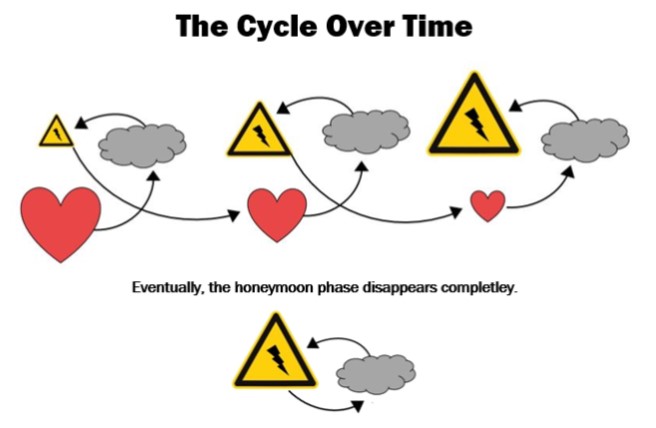Abuse comes in many forms such as physical, verbal, emotional and sexual. People being abused by their partners are not constantly being abused and the abuse is never inflicted at totally random times. There is a definite pattern for the abuse, which is recurring and appears to have three distinct phases. This pattern is commonly referred to as the CYCLE OF ABUSE.

The first phase is the “Honeymoon Phase”. This phase is how the relationship starts. The abusive individual creates a safe space filled with love and a sense of security in the relationship. This phase holds a significant draw for the person who is experiencing the abuse as feelings of love are very powerful. The abusive person acts in ways they know their partner will desire and appreciate.
The second phase is the “Tension Building Phase”. During this phase, the person experiencing the abuse is aware that tension within the relationship is increasing. The abusive partner may give the other partner the “silent treatment”, refusing to answer them or answering only in grunts. The abused individual tries to keep their abusive partner from becoming angry. For example, if he complains the children are too noisy, she quiets them or puts them to bed. If she does not like the clothes he is wearing, he changes into clothing in hopes she will approve.
At this phase, some common terminology and actions used to control the abused individual are:
- “Don’t push it”
- “If you loved me”
- Questioning and jealousy
- Withdrawing and sulking
- Silent Treatment
- Broken Promises
- Manipulation and mind games
- Blaming
The tension continues to grow and the “Explosive Phase” occurs. This is the time that the abusive behaviour occurs whether it’s verbal, emotional, sexual and/or physical. There is nothing the person who is experiencing the abuse can do to prevent the abusive behaviour. No matter what, the abusive individual will find an excuse to abuse.
At this phase, some common terminology and actions used to control the abused individual are:
- “You pushed me too far this time”
- “Why would you make me do this to you”
After the abusive event, the abusive partner tries to get the relationship back the “Honeymoon Phase” by becoming the partner the other fell in love with. In order to do this, the abusive partner is often sincerely sorry for the abuse and many promises are made, saying “I’ll never do it again.”, “I’ll go to marriage counselling.”, “I’ll quit drinking.” However, in time, the tension begins building again and another explosion occurs.
At this time, some common terminology and actions used to control the abused individual are:
- “I love you; I’m sorry”
- “I was drunk”
- “Don’t leave me”
- “It’ll never happen again”
- “We can work it out; I’ll go for counselling”
- Begs for forgiveness
- Romance, gifts (flowers, jewelry)
- Quits drugs/alcohol
- Begs for forgiveness
- Regret and remorse
- Suicidal threats
This cycle of abuse will repeat itself again and again. In most abusive relationships the abuse becomes more frequent and severe and the Honeymoon Phase becomes shorter and shorter, and sometimes even disappears completely. The longer the cycle is allowed to continue the more dangerous it becomes for the person being abused and the less strength they have to employ a plan to leave.

Feelings and behaviours of those involved during each phase.
The Tension Building Phase
Partner Experiencing Abuse:
- Feelings – angry, unfairly treated, hopeless, tense, afraid, embarrassed, humiliated, disgusted or depressed
- Behaviour – nurturing, accepting, works to diffuse partner’s anger and frustration, may verbally express own feelings of anger or may use alcohol or drugs to avoid the situation
Abusive Partner:
- Feelings – tense, frustrated, disgusted, self-righteous or jealous
- Behaviour – verbally abusive, fits of anger, silent, controlling, uses alcohol or drugs, possessive, demanding or irritable
Children:
- Feelings – afraid, tense, angry at parent for not “fixing” the abuser or confused
The Explosive Phase
Partner Experiencing Abuse:
- Feelings – frightened, trapped, helpless or numb
- Behaviour – may try to protect self, hit back or submit helplessly, may try to get away or seek help, may feign unconsciousness
Abusive Partner:
- Feelings – angry, enraged, disgusted, self-righteous, jealous or frustrated
- Behaviour – dangerously violent, deliberate desire to hurt or kill, out of control or irrational
Children:
- Feelings – frightened, trapped and helpless
- Behaviour – may watch helplessly, hide or attempt to stop fighting, may attempt to help or join in beating the victim
The Honeymoon Phase
Partner Experiencing Abuse:
- Feelings – relieved, angry over the incident, guilty or hopeful
- Behaviour – offers excuses for batterer, talks, tries to settle,solve or prevent future incidents
Abusive Partner:
- Feelings – apologetic, remorseful, forgetful about degree of violence, self righteous or unable to understand why victim is still angry
- Behaviour – makes promises to change, blames others and victim for life situations and actions, especially alcohol
Children:
- Feelings – embarrassed, humiliated, relieved, guilty or angry
- Behaviour – try to please, distract self to forget about stress behaviours, nervous or tics
